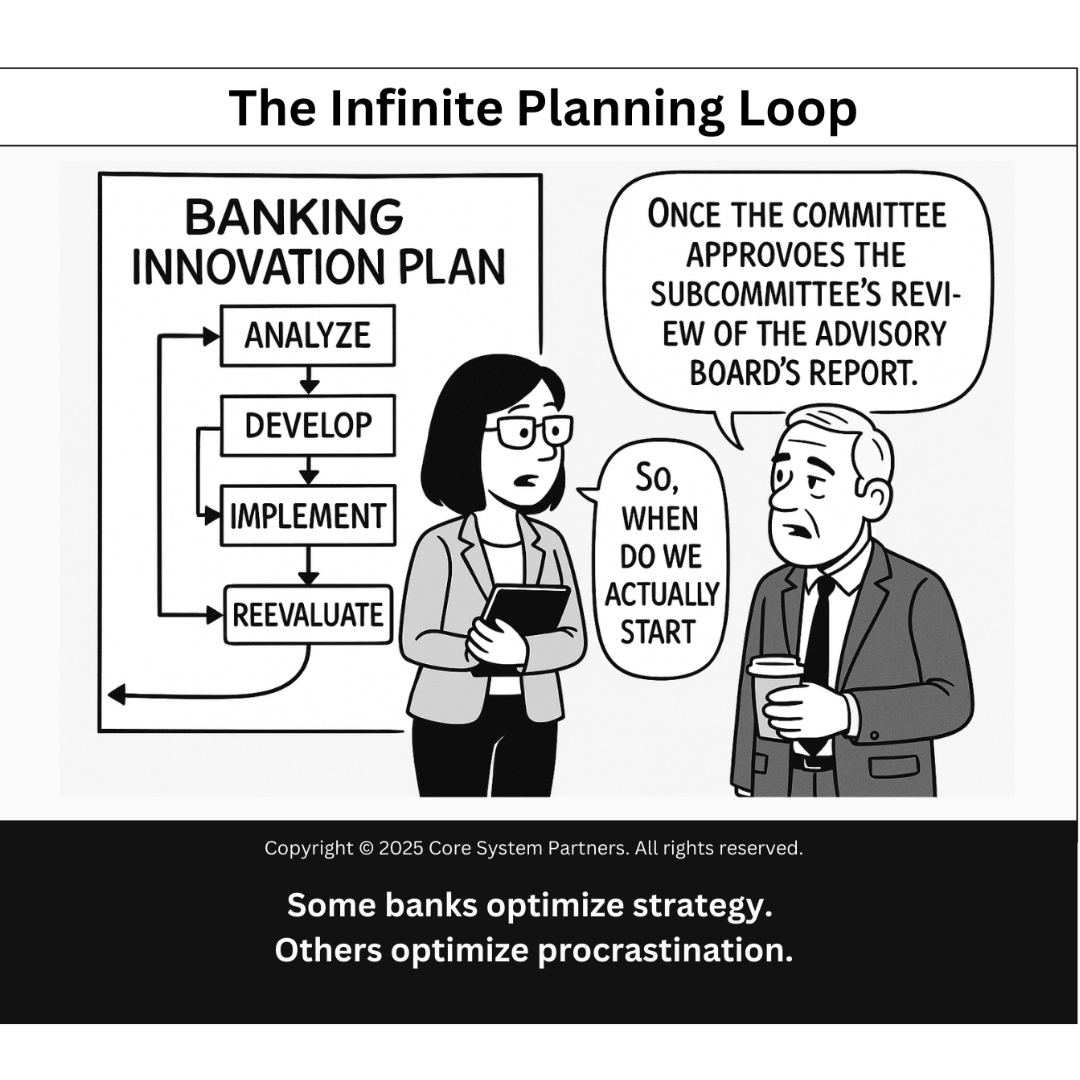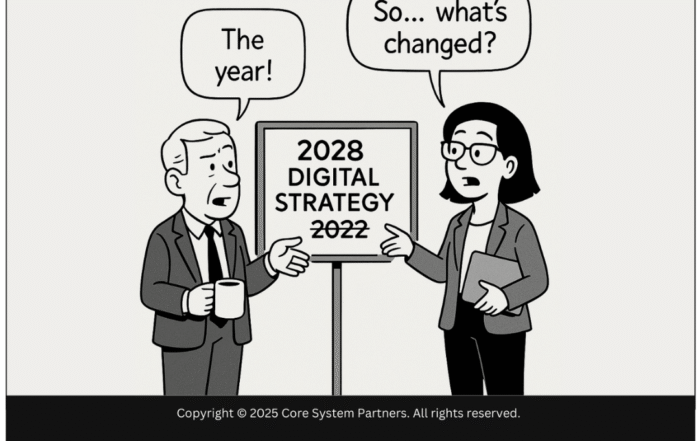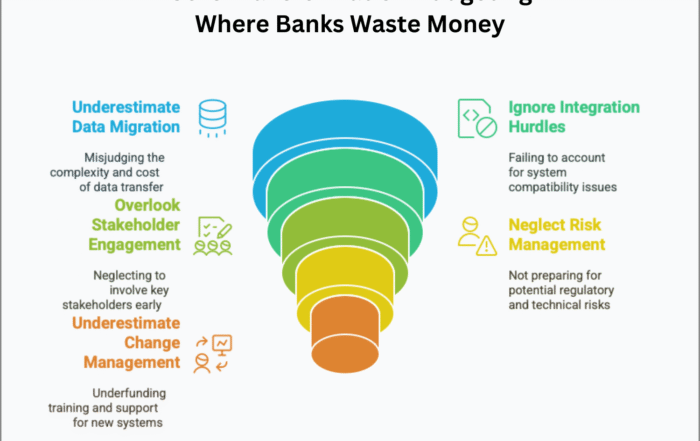
Stuck in endless planning? Break the loop and move from strategy to execution with actionable steps and the OptimizeCore® Scorecard to drive your core banking transformation forward.
Have you ever been caught in a strategy cycle that goes nowhere?
One bank exec said it perfectly: “We’ve had more planning meetings than I can count. We’ve got plans for our plans. What we don’t have is action.”
If you’ve ever watched a core banking transformation initiative spin endlessly in circles—analyze, develop, implement (almost), reevaluate, repeat—you know precisely what this cartoon pokes fun at.
On paper, it looks like progress. In practice, it’s a masterclass in organizational stalling.
Let’s unpack why this happens, what it’s costing your bank, and most importantly, how to break the loop.
The Planning Trap (and Why It Feels So Safe)
Let’s be honest: planning is comfortable. It feels productive. It checks boxes. It keeps the risk low. No one ever got fired for writing a strategy memo.
But here’s the trap: when every decision is funneled through a subcommittee that reviews a working group’s findings based on an advisory board’s recommendation… progress slows to a crawl, and execution becomes a distant dream.
Sound familiar?
- You have a transformation strategy, but no deployment date.
- You’ve held eight workshops but haven’t touched a core system.
- Your “go-live” has been rescheduled four times and counting.
Many banks find themselves stuck in this situation—not because of a lack of intention but because of overoptimization of planning.
Why This Happens in Banking
Banking has every reason to be cautious. We’re stewards of other people’s money, and we operate in highly regulated environments. Change can’t be careless.
But when caution morphs into analysis paralysis, we trade risk aversion for strategic atrophy. A few common culprits:
- Governance overload: Too many approvals and sign-offs before action.
- Fear of failure: Nobody wants to be the first to “go live” and get it wrong.
- Legacy culture: Success has traditionally meant caution, not speed.
- Lack of clarity on ownership: Who’s actually accountable for pulling the trigger?
And of course: It’s easier to delay than to decide.
The Real Cost of Infinite Planning
Let’s be clear—the cost of inaction is real. Every day spent stuck in planning limbo is a day competitors move forward. Here’s what you’re likely losing:
- Innovation velocity: You fall behind on deploying capabilities your customers now expect.
- Operational efficiency: Old systems stay in place, dragging down performance.
- Talent morale: Staff get fatigued by endless loops with no real progress.
- Customer trust: Modern banks deliver change fast; if you don’t, they’ll find someone who does.
And the irony? The longer you plan without acting, the riskier the transformation becomes. Tech debt grows, systems age, and momentum disappears.
Signs You’re in an Infinite Loop
Are you stuck in one? Here are a few telltale signs:
- Your project timelines keep moving “just one more quarter out.”
- There’s no apparent decision-making authority, or too many.
- Team members refer to the plan more than the implementation.
- You’ve “restarted the roadmap” more than twice in a year.
- Nobody knows when go-live is… or if it’s even real.
How to Break the Loop and Move Forward
Good planning is still essential. But it has to be paired with bold, well-informed execution. Here’s how to get unstuck:
- Set a Clear Decision Point—and Stick to It
Pick a date, a gate, a milestone—whatever works. But make it real. No more “we’ll revisit next quarter” vagueness.
“The best planning deadline is the one you don’t push.”
- Empower a Core Execution Team
Give a cross-functional team the authority to move. Strategy without ownership goes nowhere. If everyone owns it, no one does.
- Use Pilot Projects to De-Risk Action
Don’t launch everything at once. Start small. Prove success in one branch or one product line. Pilot conversions are a great model for this.
- Make Progress Visible and Measurable
What gets tracked gets done. Publish metrics, celebrate milestones, and create internal pressure through transparency.
- Lean into Agile Principles
Core banking doesn’t need to be slow by design. Use agile sprints, iterate, and build confidence in waves—not just once a year.
The Bottom Line: Strategy Without Action Is Just a Loop
The cartoon says it best:
Some banks optimize their Strategy. Others optimize procrastination.
If your organization has been stuck in the infinite planning loop, it’s time to ask the tricky question: what are we actually waiting for?
You don’t need a perfect plan. You need a good plan—executed well, with room to adapt. The longer you wait to start, the more you’ll have to fix later.
Ready to Get Unstuck?
Do you want to know whether your core banking transformation can move from Strategy to execution?
Start with the OptimizeCore® Scorecard, a no-nonsense diagnostic tool for assessing your organization’s readiness across the most critical dimensions: governance, tech stack, operations, stakeholder alignment, and more.
Don’t let the planning loop define your bank’s transformation story. The path to impact starts with a single step: action.
#CoreBankingTransformation #CoreBankingOptimization





